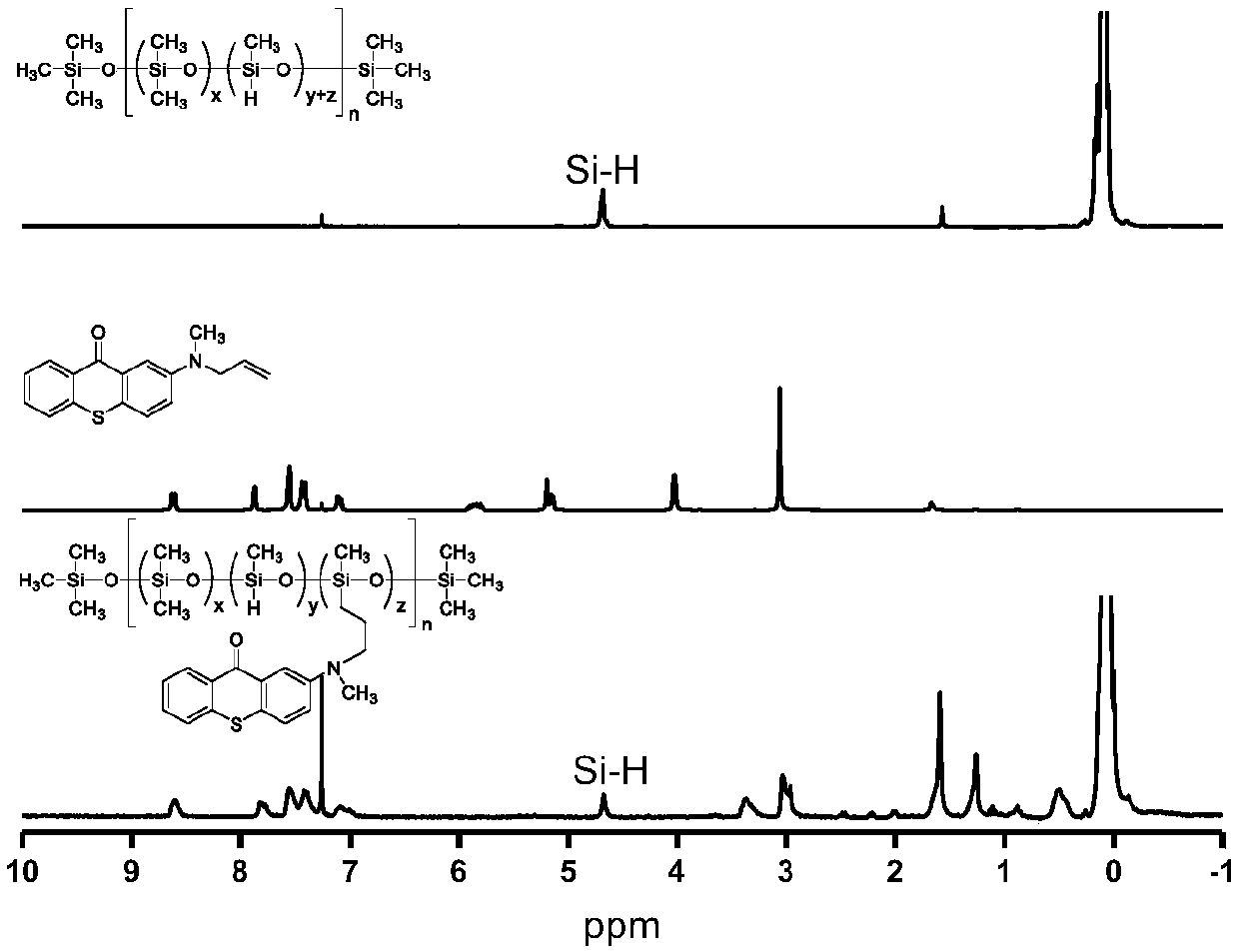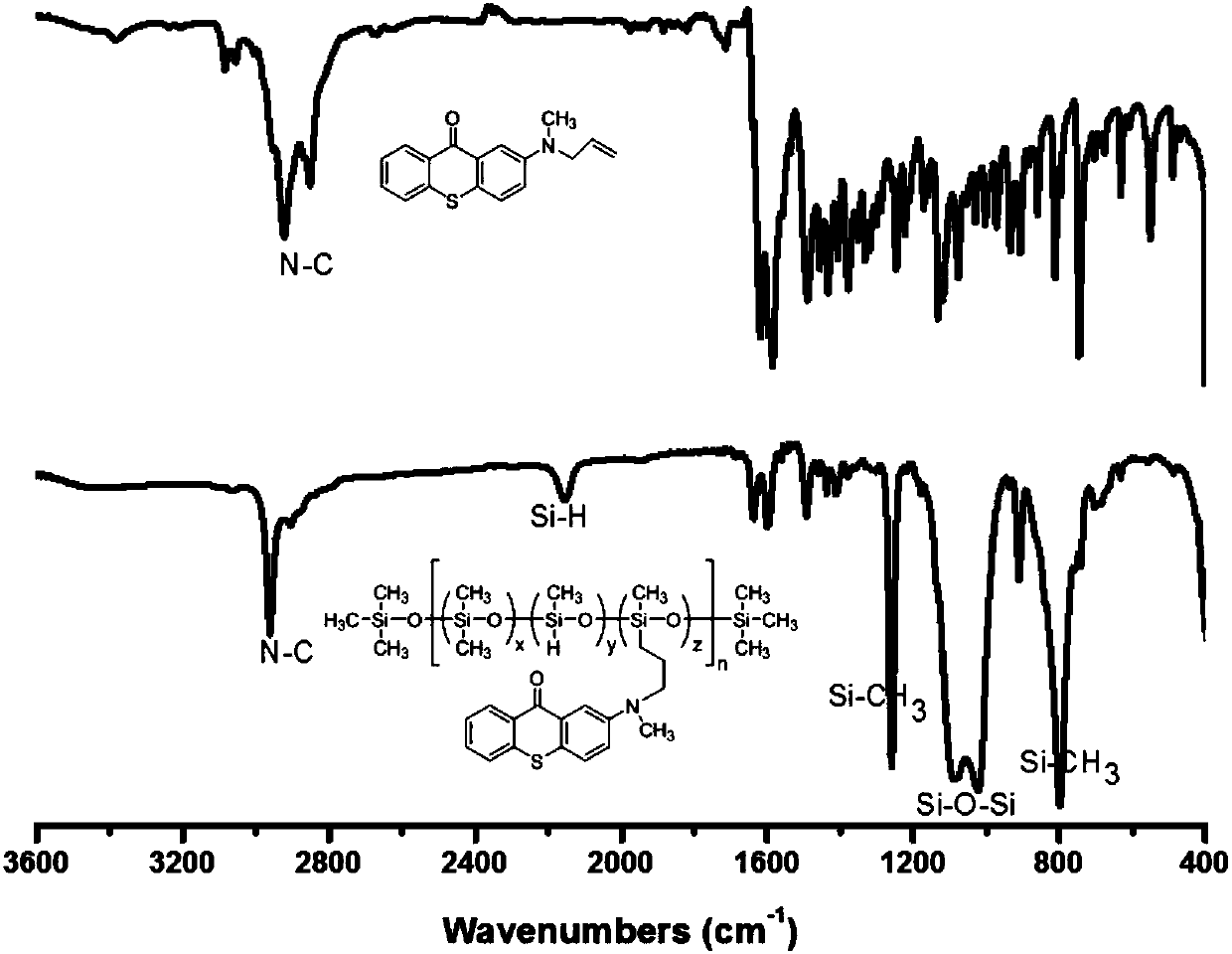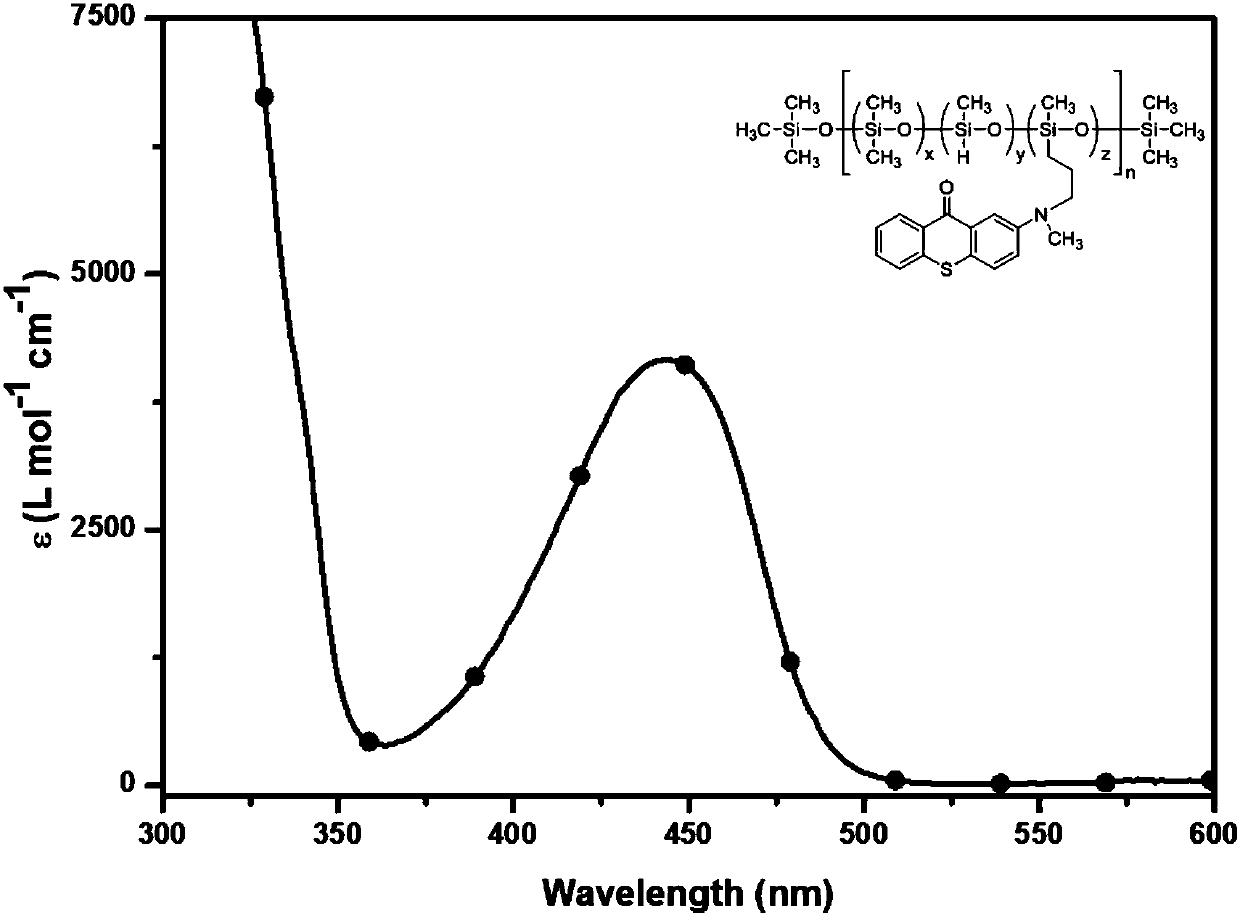Mono-component polysiloxane photoinitiator capable of overcoming oxygen polymerization inhibition and preparation method therefor
A technology of photoinitiator and polysiloxane, applied in the field of photoinitiator, can solve problems such as poor compatibility and influence effect, and achieve the effects of high initiation efficiency, convenient cost control and convenient adjustment
- Summary
- Abstract
- Description
- Claims
- Application Information
AI Technical Summary
Problems solved by technology
Method used
Image
Examples
Embodiment 1
[0041]
[0042] Preparation method: Weigh 0.14g (0.5mmol) 2-(N-methyl-N-allyl)thioxanthone and 0.7g 0.30wt% hydrogen-containing polysiloxane (x=0.75 , y+z=0.25, n=28), under an argon atmosphere, add 30 mL of anhydrous tetrahydrofuran and a system of 500 ppm [Pt] Karstedt catalyst, stir the reaction at 25 ° C, and wait for 2-(N-methyl-N-ene After the reaction of propyl)thioxanthone was complete, the tetrahydrofuran was removed under reduced pressure to obtain a single-component polysiloxane photoinitiator capable of overcoming oxygen inhibition, which weighed 0.84 g after drying.
[0043] Proton NMR spectrum:
[0044] 1 H NMR (CDCl3 ,300MHz)δppm: -0.25~0.30(br,40H,Si-CH 3 ),0.35~0.60(br,2H,SiCH 2 ),1.16~1.36(br,2H,SiCH 2 CH 2 ),2.89~3.12(br,3H,NCH 3 ),3.18~3.49(br,2H,NCH 2 ), 4.68(s, 0.67H, Si-H), 6.90~7.15(br, 1H, Ar-H), 7.31~7.48(br, 2H, Ar-H), 7.49~7.66(br, 2H, Ar- H), 7.70-7.90 (br, 1H, Ar-H), 8.56-8.72 (br, 1H, Ar-H). FT-IR (film, cm -1 ):ν=2154(Si-H), 1594(C=...
Embodiment 2
[0048]
[0049] Preparation method: weigh 0.32g (1.0mmol) 4-(N-methyl-N-allyl)-N-(2-methoxyethyl) naphthalene diimide and 0.28g 0.70wt% hydrogen-containing polysiloxane (x=0, y+z=1, n=2), under an argon atmosphere, add 20mL of anhydrous dioxane and a system of 100ppm [Pt] Sperier's catalyst, control The reaction temperature was 40°C. After the reaction of 4-(N-methyl-N-allyl)-N-(2-methoxyethyl)naphthalene diimide was completed, it was cooled to room temperature under an argon atmosphere. The dioxane was removed under reduced pressure to obtain a one-component polysiloxane photoinitiator capable of overcoming oxygen inhibition, which weighed 0.60 g after drying.
[0050] Proton NMR spectrum:
[0051] 1 H NMR (CDCl 3 ,300MHz) δppm: -0.01~0.210(Si-CH 3 ),0.84~0.93(SiCH 2 ), 1.17~1.24 (SiCH 2 CH 2 ), 3.04 (NCH 3 ), 3.37 (OCH 3 ),3.67~3.78(NCH 2 ,CH 3 NCH 2 ),4.41~4.46(OCH 2 ), 4.67(Si-H), 7.12~7.16(Ar-H), 7.61~7.67(Ar-H), 8.40~8.43(Ar-H), 8.47~8.49(Ar-H), 8.56~8.58...
Embodiment 3
[0055]
[0056] Preparation method: Weigh 0.13g (0.5mmol) 2-(allyloxy)thioxanthone and 0.89g0.14wt% hydrogen-containing polysiloxane (x=0.9, y+z=0.1 , n=200), under argon atmosphere, add 20mL of anhydrous tetrahydrofuran and the Sperier's catalyst of system 500ppm [Pt], control the reaction temperature to tetrahydrofuran reflux, after the reaction of 2-(allyloxy)thioxanthone is complete , cooled to room temperature under argon atmosphere. The tetrahydrofuran was removed under reduced pressure to obtain a one-component polysiloxane photoinitiator capable of overcoming oxygen inhibition, which weighed 1.00 g after drying.
[0057] Proton NMR spectrum:
[0058] 1 H NMR (CDCl 3 ,300MHz) δppm: -0.01~0.21(Si-CH 3 ), 0.72 (SiCH 2 ), 1.62 (SiCH 2 CH 2 ), 3.90 (O-CH 2 ), 6.94(Ar-H), 7.09(Ar-H), 7.26(Ar-H), 7.35(Ar-H), 7.42(Ar-H), 7.51(Ar-H), 7.58(Ar-H) .
[0059] UV maximum absorption peak: λ max = 402nm.
[0060] It can be seen from the spectrum data that 0.72(SiCH 2 )...
PUM
 Login to View More
Login to View More Abstract
Description
Claims
Application Information
 Login to View More
Login to View More - R&D
- Intellectual Property
- Life Sciences
- Materials
- Tech Scout
- Unparalleled Data Quality
- Higher Quality Content
- 60% Fewer Hallucinations
Browse by: Latest US Patents, China's latest patents, Technical Efficacy Thesaurus, Application Domain, Technology Topic, Popular Technical Reports.
© 2025 PatSnap. All rights reserved.Legal|Privacy policy|Modern Slavery Act Transparency Statement|Sitemap|About US| Contact US: help@patsnap.com



